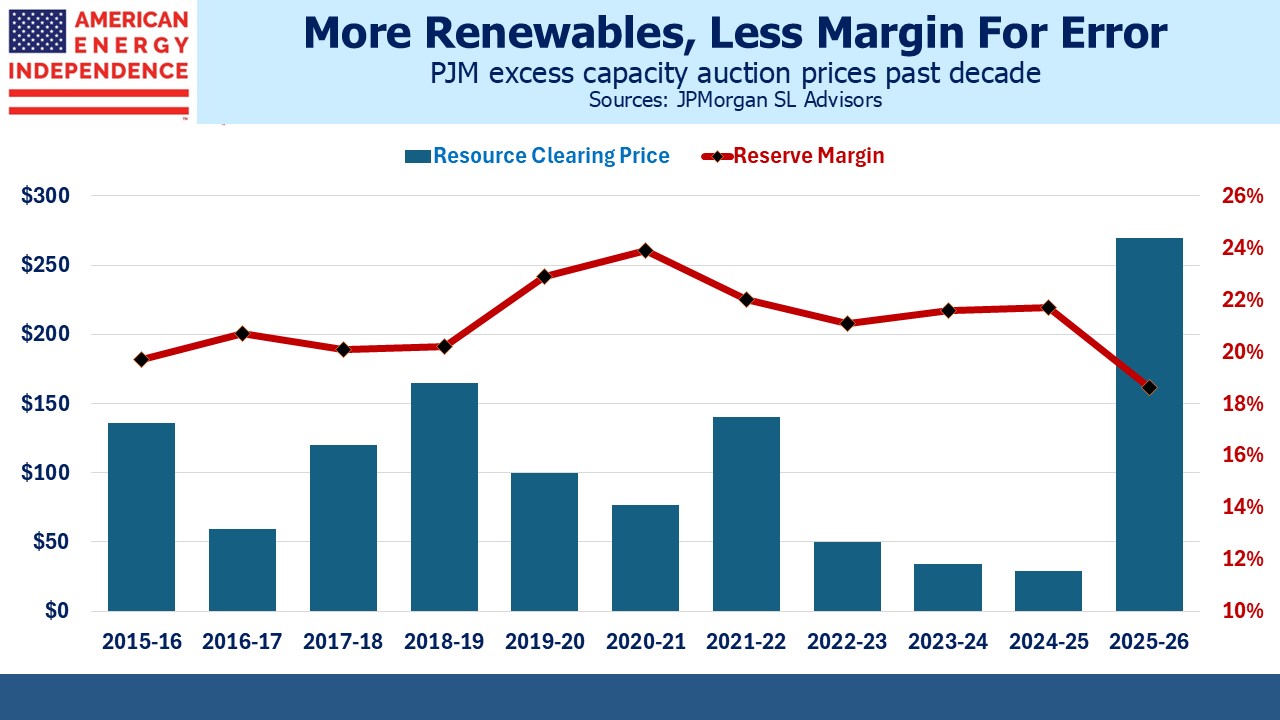The Coming Fight Over Powering AI
US natural gas and its related infrastructure isn’t the only beneficiary of the AI-driven boom in power demand. Utility stocks have been rising, as investors assess growing power demand will boost earnings. The S&P Utilities Index is several per cent ahead of the S&P500 this year.
Operators of data centers well understand the challenges they face in obtaining reliable electricity. This is coming at a bad time for grid operators, who are already struggling to incorporate renewable sources into their power mix. Weather-dependent solar and wind operate 20-35% of the time. This requires increased redundancy across a grid as they add more dispatchable power (mainly natural gas) to compensate for when it’s not sunny or windy.
Some data centers are lining up their own sources of electricity. One example is a campus owned by Amazon Web Services (AWS) in Pennsylvania that will buy power from Talen Energy’s Susquehanna nuclear facility. But the AWS data center will retain access to the grid, run by PJM, the regional transmission organization.
Electricity markets are complicated. Exelon and American Electric Power (AEP), who operate within PJM’s region, have filed a formal protest with the Federal Energy Regulatory Commission (FERC). They are challenging Susquehanna’s application for a non-conforming Interconnection Service Agreement (ISA).
It’s not possible to assess the merits of this protest from public documents. But the filing does offer insight into issues that are likely to become common areas of dispute among industrial customers, power providers and regulators.
The infrastructure that delivers electricity (ie power lines, transmission stations etc) represents a significant fixed cost that is shared across customers approximately according to how much electricity they use. Residential solar panels are already challenging this model – California no longer credits homes that send excess power back to the grid at the same price they pay, because the economics no longer work.
The Exelon/AEP protest suggests that Susquehanna is trying to connect to the grid without fully paying for its costs. It asks why the nuclear facility will synchronize its power with the grid while still claiming to be separate from it. Data centers need extremely stable power with minimal harmonic distortions, so perhaps there are technical reasons Susquehanna needs to be “synchronized” with the grid.
The protest goes on to note that another unit at the facility had an unplanned outage last year, but apparently “no load was dropped” suggesting that grid power made up the shortfall.
Exelon/AEP are telling FERC that Susquehanna wants to “…operate as a free rider, making use of, and receiving the benefits of, a transmission system paid for by transmission ratepayers while not sharing in the costs.”
Susquehanna retorts that the protest is stifling innovation. As the competition for reliable power intensifies, such disputes will become more common.
Meanwhile, PJM recently held an auction to provide their Regional Transmission Organization Reliability Requirement for the 2025-26 delivery year. Think of this as surge capacity to be available during a heatwave or when a substantial portion of its generating capacity is down. Unsurprisingly, solar and wind represented just 2% of the responses to the auction, since they produce power when they can, not necessarily when it’s needed. Natural gas was 48%.
PJM is estimating they’ll need 2% more surge capacity than in the prior year. The auction cleared at $269.92 per Megawatt-Day, more than 9X the prior year’s 28.92 figure. Moreover, their reserve margin shrank from 20.4% to 18.5%.
This is not good news for PJM customers. PJM attributed the price jump in part to the loss of 6.6 Gigawatts of generation capacity (mostly coal) that is retiring. Because it’s not being replaced at the same rate, there’s less power available.
The North American Electric Reliability Corporation has warned grids across the country that the energy transition as it’s currently being implemented is reducing reliability and increasing the risk of power cuts.
Solar and wind are especially useless at providing surge capacity because their operators can’t be certain how much they can produce. Natural gas was almost half because it’s “dispatchable”, meaning it can be delivered when needed. It’s another example of the inferior quality of solar and wind compared with traditional energy.
JPMorgan suggested that another reason for the price jump is that power providers are holding back, skipping the auction while they negotiate long term contracts with data centers.
The hunger for power to support AI is on a collision course with plans to decarbonize our electricity. Old forecasts of modest 1% annual demand growth driven by EVs is now turbo-charged to 5% or more. Globally, added renewables are unable to even meet the increase in primary energy consumption across developing countries. In the US the Exelon/AEP dispute with Susquehanna is only the first of many.
Energy investors will be learning more than they expected about the commercial intricacies of America’s electricity supply.
We have three have funds that seek to profit from this environment:
